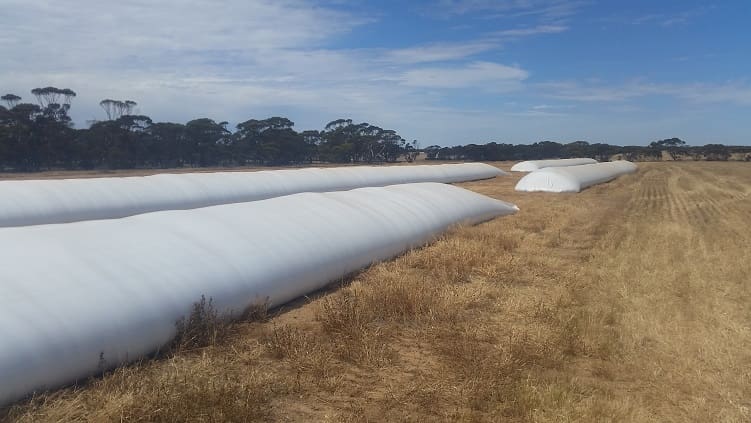
Research with GRDC investment being carried out by SEPWA is finding grain can be stored in these types of grain bags at harvest with limited risks of quality damage or poor germination in retained seed for the following year. (Photo: SEPWA)
AN INCREASING trend by growers to store grain in grain bags after harvest has led to new research into the impacts of this type of on-site storage on cereal seed quality.
Results to date from the South East Premium Wheat Growers Association’s (SEPWA) ‘Bagging grain profits’ project in Western Australia are giving this tactic a tick of approval, with minimal evidence of adverse impacts on grain quality or seed germination rates after planting the following year.
The group conducted trials of grain bags across the Esperance region during the 2017-18 harvest, as part of a suite of Grains Research and Development Corporation (GRDC) investments into local issues that have been identified by grain growers as impacting on their profitability.
SEPWA’s research will be repeated during this year’s harvest period and include monitoring grain quality factors such as seed moisture, protein levels, temperature, colour and germination, and assessing any market liability risks.
Temperatures
SEPWA project officer Aidan Sinnott said results from last summer indicated daytime maximum temperatures, including quite big fluctuations from low-20⁰ Celsius levels up to the mid-40⁰C range, did not have a big effect on temperatures inside the grain bags.
He said across the trial sites, and after about 40 days of storage in the bags, barley and wheat grain moisture was maintained at industry acceptable levels of about 13-14 per cent and grain quality was not adversely impacted by this type of storage in the summer conditions.
Mr Sinnott said at one location, wheat did heat up more than barley when monitored in grain bags for 38 days at an average daytime temperature of about 20⁰C, but not to a level that impacted on its key quality parameters.
Germination rates
Part of the ‘Bagging grain profits’ project was to assess the germination rates of cereal seed retained in grain bags after sowing in 2018.
Across all trial sites, germination rates were 99-100pc for this seed, some of which was stored in grain bags for up to 74 days.
“Overall, there was very little effect on seed germination percentages for wheat and barley stored in grain bags in the conditions experienced in the 2017-18 harvest and summer period,” Mr Sinnott said.
“During the coming harvest, we plan to extend the storage period of grain in bags and add other crop types to our evaluation.
“At the end of the two-year GRDC-SEPWA project, we hope to have developed comprehensive tips for using grain bags and best-practice guidelines for industry stakeholders down the supply chain, including how to manage any potential grain quality risks.”
Logistical advantages
Mr Sinnott said the use of grain bags for on-site storage was now a recognised management tactic in WA, providing logistical advantages for growers in allowing them to fast-track harvest operations, manage grain moisture and quality and capture freight cost advantages.
“SEPWA advocates early harvest in the South Coast region to optimise grain quality and crop value,” he said.
“Grain bags enable management of moisture and quality parameters prior to grain leaving the farm, or can be used for storing retained seed for subsequent planting.
“Use of these bags also offers opportunities for growers to access grain quality upgrades and extend the truck freight period to further reduce peak harvest grain freight costs.”
GRDC grower relations manager – west, Lizzie von Perger, said the SEPWA-led ‘Bagging grain profits’ project was the direct result of this issue being raised as a challenge by WA growers.
“It is vitally important that GRDC responds to emerging issues, such as optimising results from the use of innovative grain storage tactics, in a timely manner,” she said.
Source: GRDC
The GRDC has a comprehensive Stored Grain information hub at http://storedgrain.com.au and a GrowNotes™ Grain Storage resource at https://grdc.com.au/grain-storage-grownotes.

HAVE YOUR SAY